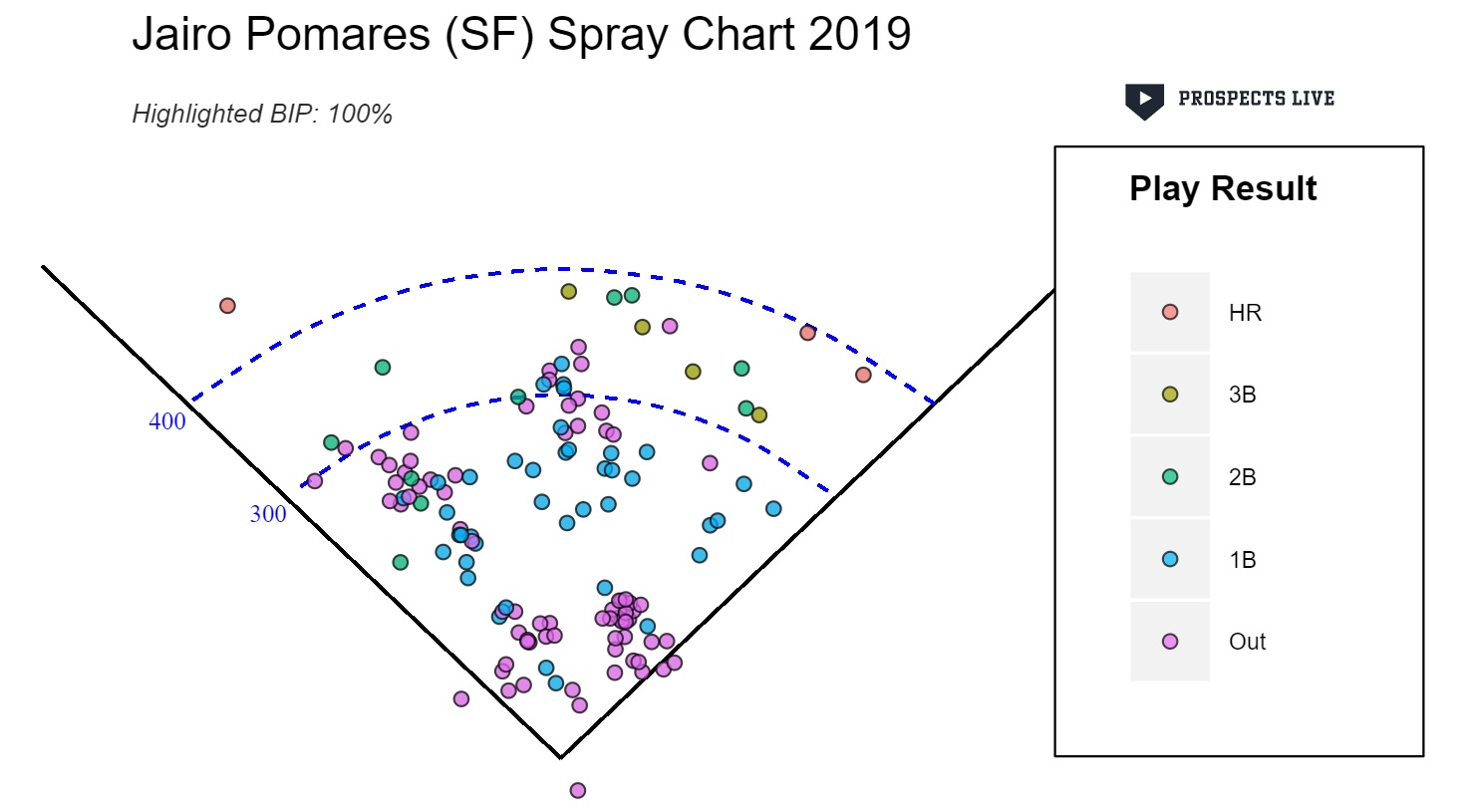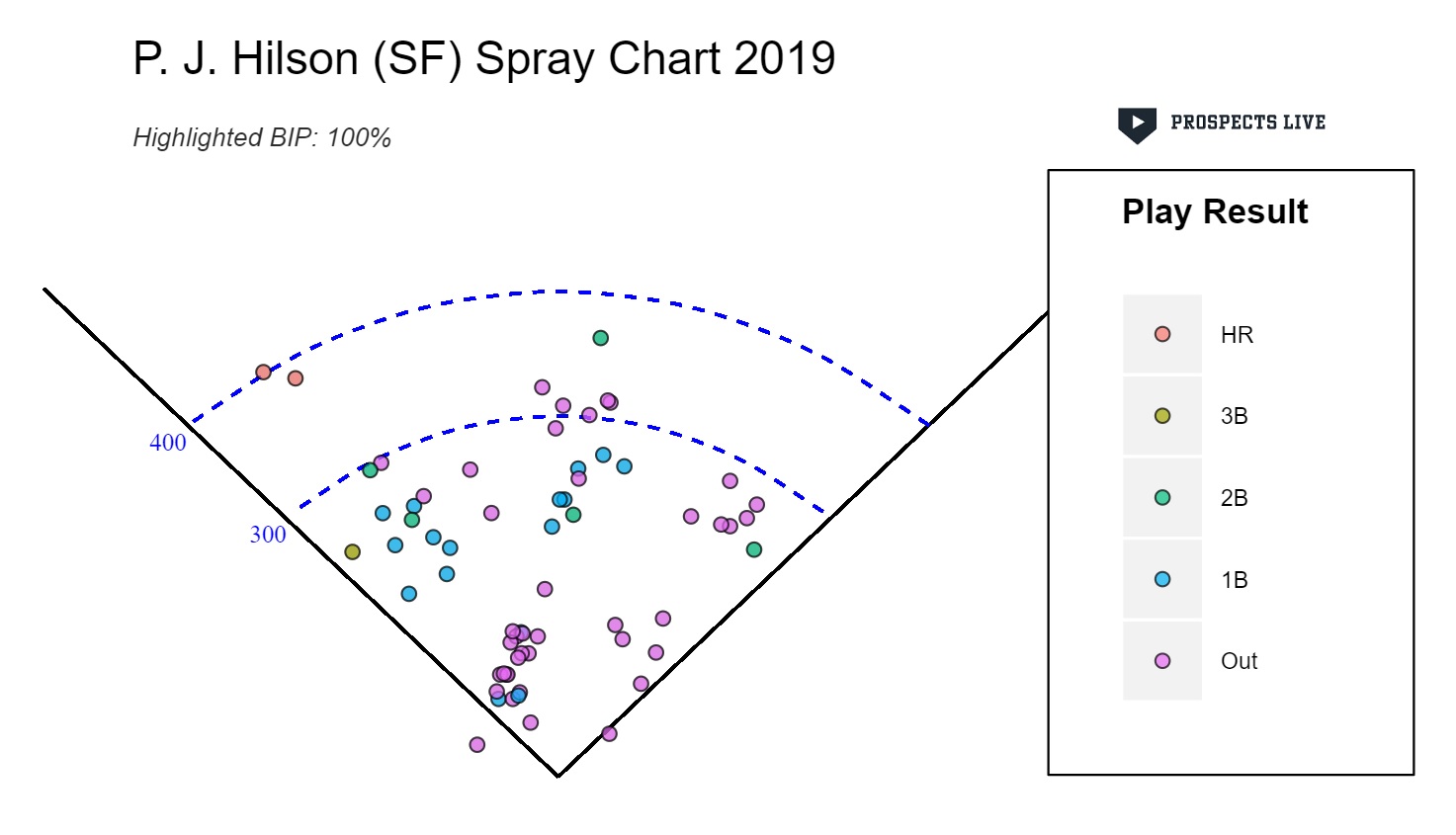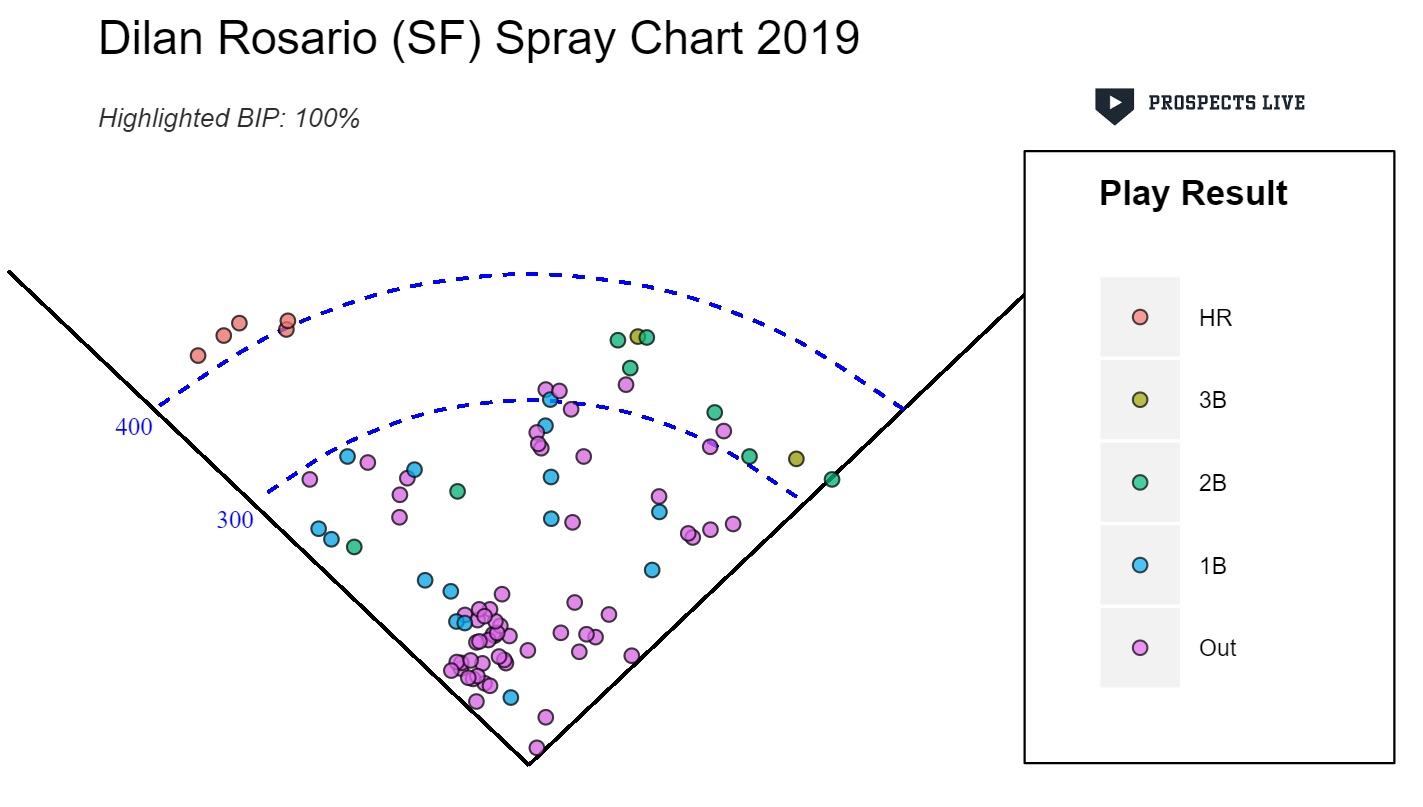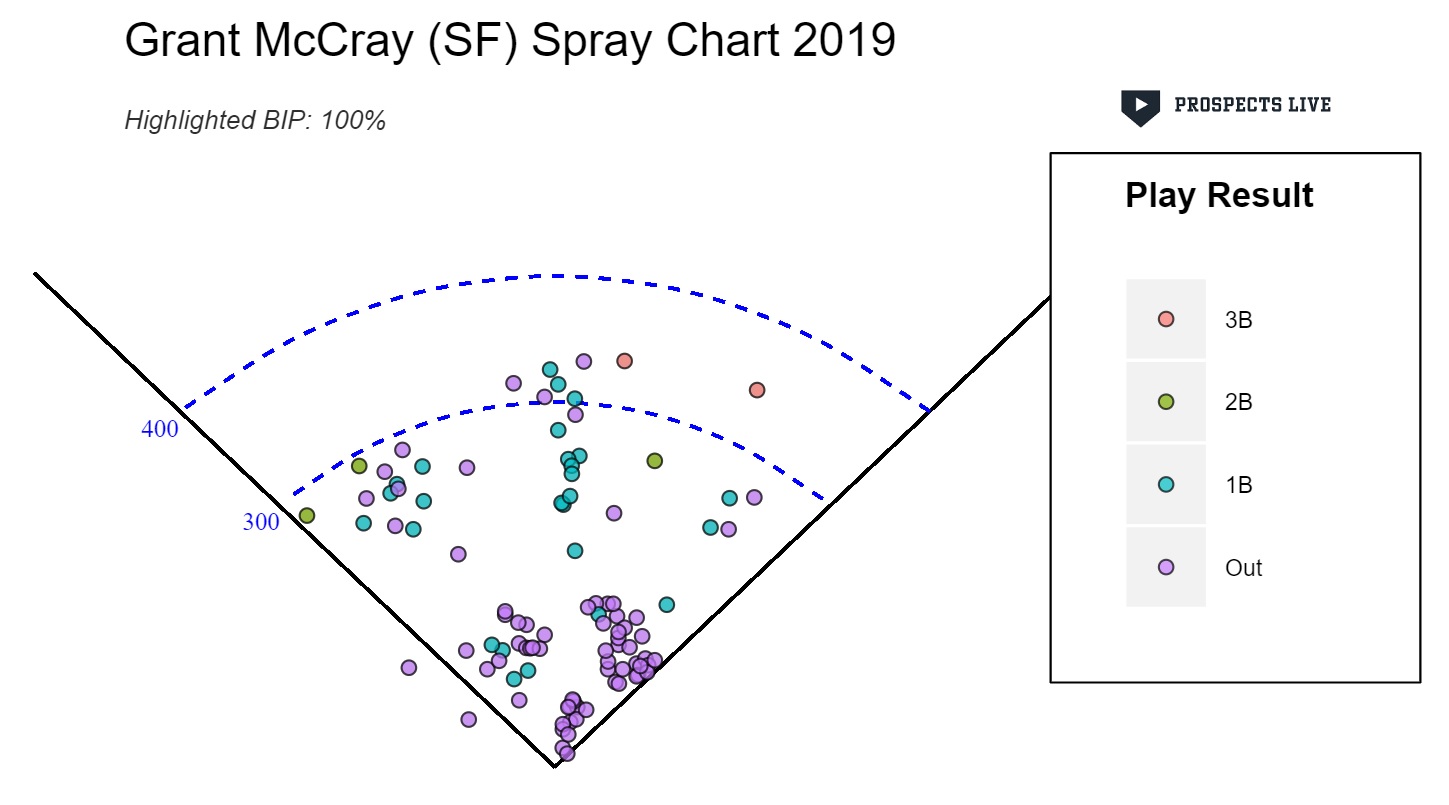From 8/1-8/6 I sat on the Giants Orange roster. In late July I caught the Giants Black while viewing other teams; they were not my primary focus. The top talent on the Giants complex comes from the international market: Marco Luciano ($2.6MM) and Jairo Pomares ($975,000) are both high-touted 2018 J2 signings. Luciano is arguably a top 30 prospect in baseball with elite bat speed and double-plus game power projection. Pomares is a bat-first corner outfielder with everyday potential. Luis Toribio signed for $300k in 2017 and has hit his way onto Giants top 30 lists. Several recent draftees show promise but have hurdles to clear to become impact players: P.J. Hilson is a speedy centerfielder with plus bat speed and Dilan Rosario is a shortstop with plus raw power.
Marco Luciano (SS) – The top 2018 J2 signee, Luciano was listed at 6’2” 178 lbs on signing day. He is still relatively thin but has wiry, sinewy strength. The body looks capable of adding moderate weight as he matures, which will translate to more power. In January Luciano put on an indelible display of raw power in BP launching balls out to all fields, a skill few 17-year-olds have. In games Luciano has a pull-heavy approach but has flashed all fields power. Flatly, Luciano has some of the best hands/bat speed on the planet; they power his swing and should help him maintain reasonable contact rates without having to sell out for power. He projects to be an above average hitter with double-plus game power at maturity.
Luciano can be beaten by spin at present, but he has made improvements in pitch ID and pitch selection over the course of the season. It is difficult to determine how much of this improvement should be attributed to the diminished quality of pitching from extended to the AZL, but it is obvious Luciano has made improvements regardless. His aptitude for adjustments is encouraging, inspiring optimism he will make similar changes as he climbs into the upper minors. One potential area of concern are his splits versus left-handed pitching. As of 8/14 he was slashing .172/.294/.241 vs lefties with just two extra base hits in 34 plate appearances. Luciano only faced one lefty in my five-game sample, making it hard to determine if/why he is struggling vs them or if this is a small sample mirage. At 34 PAs, we are far from meaningful stabilization points for most stats, but this is something to monitor going forward.
Luciano’s defense needs some work; a few fairly-routine balls ate him up, bouncing off his glove. His defensive actions looked better in INF practice than in games. Overall, he did not look overly instinctive at short and took sub-optimal paths to the ball; there was an element of indecision in how he moved around. Luciano’s run times also raise the question of whether he will maintain enough range for shortstop; he posted 30-40 times, but he looks like a fringe-average runner. Added weight will likely push him into 40-speed territory. Luciano throws from a lowish angle, and he did not make many max effort throws, but his arm was around average to a tick above; it could play at third. A move to third is a logical transition because indecision in his reads and diminished range would be largely mitigated. Worst case scenario is a move to the outfield where Luciano’s bat is so special, it would still play. The most-likely outcome is 40-grade defense at the hot corner.
Overall: FV 60 – Hit 30/55, Power 50/70, Defense 20/40, Arm 50/55, Speed 45/40
Jairo Pomares (OF) – The Giants 2018 J2 class was a coup, and Pomares was the coup part deux. Any Pomares writeup should start with his bat, which was one of the most advanced in the AZL this year. Bat speed is plus and Pomares has good feel for the barrel; he shoots balls to all fields and effectively defends both sides of the plate. His offensive approach is aggressive; Pomares hunts fastballs early in counts and goes after the first pitch often (to wager a guess 40% of the time). He has necessary bat speed to touch velo, but his hands remain fairly high through slot position which makes his swing long. The resulting parabolic bat path should in theory generate a lot of fly balls, but Pomares sometimes cuts off his swing, instead chopping downward with a low attack angle. It happens naturally as a way of making contact. The full parabolic path is reserved for pitches he knows he can square up and mistake breaking balls that get too much plate. The aggressive/opportunistic nature of his approach may be exploited at higher levels where pitchers will make fewer mistakes and be better equipped to pitch backwards early in counts. Pomares tracks spin fairly well though, and he has shown the ability to battle and hang in against good competition. He faced Brennan Malone on 7/28, fouling off several mid-90s fastballs and spitting on sliders down and in en route to a walk. Malone did not have great feel for his slider that day, but it was still an encouraging PA for Pomares. At the end of the day, his aggressiveness seems more a deliberate choice than a forced decision because he has handled secondary pitches well. Pomares projects for an above average bat and average game power at maturity.
Defensively, Pomares is below average. His speed is average but range is around 40-grade because his reads and reactions are below average. Pomares is good enough to stick in the outfield, but he does not look special there. The likely landing spot is left because the arm is average or a tick below; he could play right in a pinch but would not be ideal there. Don’t let his defensive profile obfuscate the bigger picture; Pomares projects to be an everyday player, and there not many players of this caliber in the AZL. He could be something like Eddie Rosario, a below average defensive OF with an aggressive approach and good bat to ball skills.
Overall: FV 50 – Hit 35/55, Power 30/50, Defense 30/40, Arm 45/45, Speed 50/50
Luis Toribio (3B) – A $300k sign in 2017, Toribio emerged from relative obscurity in 2018 with a strong showing in the DSL, and he has put up comparable numbers in the 2019 AZL. Toribio has good plate discipline and a powerful rotational swing that projects for plus raw. He is very selective and will lay off pitches that are near misses, tracking pitches well and spitting on spin. Mechanically, his hands are quiet preslot; Toribio stays back and reacts. When he barrels up contact is loud, and he is capable of high EV lasers, but he also swings with a lot of effort. The max-effort swings could eat into his contact rate as faces more advanced pitching. Also notable: Toribio’s three AZL homers have all been to the opposite field, which flies in the face of what I have seen in person. The swing looks primed for pull-side contact. Toribio has not kept his hands in with intent to take pitches opposite field. When attacked away he instead tries to pull the ball and rolls over with weak ground balls. I am worried defensive positioning will erode his BABIP at higher levels in spite of his hard contact (have not seen many shifts in the AZL). The bat projects to 40 with 50 game power. Toribio is a capable defender at third with good reactions and reads. He is agile for his size. Considering his age there is some risk he loses mobility and becomes too big for the position. As-is Toribio is already a below average runner with a 4.33 max effort time from the left in my sample. The arm plays at third to the tune of 55/60. The defensive package would play at third if the bat got to average, but I am wary it gets there. His splits against right-handed pitching are strong though. The most likely outcome is platoon bench bat, but he has a role-50 regular ceiling.
Overall: FV 40 – Hit 20/40, Power 35/50, Defense 30/45, Arm 55/60, Speed 40/35
PJ Hilson (CF) – Hilson is a twitchy athlete with double-plus range center; he makes good reads and has at least plus speed. Judging from the eye test, it is 60, maybe 70 speed. Hilson also has plus bat speed with explosive hands. Pitch recognition has been an issue, and Hilson has been overmatched by spin and offspeed. The swing has changed from extended to AZL: a leg kick and twist of hips have been removed in favor of a wider base and shorter stride. The changes have not translated into production, but Hilson is still a gifted athlete with preternatural skills few other guys have. Teams from the outside looking in may view him worth a flier on his tools, but it may also depend on the degree to which they believe pitch recognition is a learned vs innate skill and self-assessment of their own player development staffs. Do they see something mechanically that can be changed to help Hilson unlock his offensive potential? Ultimately, he is an almost 19-year-old repeating the AZL and slashing .220/.298/.339. Hilson has intriguing upside but also has a lotto-ticket feel; at this juncture it feels unlikely his tools will translate to offensive production.
Overall: FV 30 – Hit 20/30, Power 20/30, Defense 50/55, Arm 50/50, Speed 65/65
Dilan Rosario (SS) – Rosario was the Giants 2019 6th rounder out of Puerto Rico. He is a strong, athletic middle infield prospect with plus raw power. His in-game power has been dead pull in the AZL. Watching him in 8/2’s BP, it became apparent he is capable of using all fields. The ball jumps off his bat with little effort; Rosario creates power through rhythm and sway. He did not show well defensively in my looks with two errors on routine plays in 7/23’s game. Roger Munter mentioned Rosario was perceived to be a strong defender coming into the draft so it is possible my look was not representative of his true talent level. Overall, his body and athleticism stand out. Rosario strikes me as a probable role 30 but is someone to keep an eye on and has an outside shot to be a role 50.
Overall: FV 30 - More looks are needed to assign tool grades.
Connor Cannon (1B) – Listed at 6’5” 240 lbs, Cannon is best described with three flexing bicep emojis. He is a huge human. Cannon is basically a one-tool prospect with double-plus raw power. It is a simple swing. He starts with his hands high, settles them to shoulder length with an easy, short stride. Brute strength provides the thunder; he had two oppo homers 8/1 and has easy plus power to all fields. Cannon looks a little awkward running and fielding. He is a 1B/DH only type and as a 21-year-old he was old for the level. While he slashed .326/.399/.689 in the AZL, he also struck out 25% of the time. He will need to mash every step of the way, and his long levers will make it difficult to tap into his power.
Overall: FV 30 - More looks are needed to assign tool grades.
Caleb Kilian (RHP) – The Giants took Kilian in the 2019 8th round out of Texas Tech and signed him for $397.5k. He was starter in college and projects as a reliever in the pros. He has a near-prototype 6’4” 180 pound pitcher frame. Kilian looks around ten pounds larger than his listed weight. Kilian has a simple, easy delivery and sat 93-96 in two single-inning stints on 8/1 and 8/6. His ease of delivery makes me wonder how he would look if he truly aired it out. Kilian’s curve flashed 55 with 11 to 5 shape in the low 70s and functions as his chase pitch. The change was around average in the low 80s. Kilian is advanced for the level and looks ready for a shot at Salem-Kizer.
Overall: FV 35 – FB 50/60, CB 50/55, CHG 40/50
Wilkelma Castillo (RHP) – Castillo is an aggressive pitcher who attacks. He sat 89-91 T92 with room for a little weight on his frame; he is thin but is around 6’0”-6’1” so there is modest physical projection. Castillo has effort to his delivery but also good arm speed. He was able to tail the fastball and spotted it on corners semi-regularly. There is some deception from his arm action, which makes the ball harder to see out of his hand. On 8/4, Castillo had trouble timing his release with several arm-side misses. He maintained composure and was able to work through it. Castillo’s curve and change both flashed above average but were not there consistently. Castillo needs to stay inside of the baseball to maintain better fade on his changeup. The breaking ball backed up on him as he struggled to supinate consistently. Castillo has a chance to be a middle reliever with more consistent shape on both secondaries and another couple ticks of velo. It feels like a mounting list of “ifs”; he is more likely a role 30 up and down guy.
Overall: FV 30 – FB 45/50, CHG 45/55, CB 45/50
A few other notable names who I have either not seen enough or are less promising: Grant McCray (3rd) and Garrett Frechette (5th) were early round picks in the 2019 draft. McCray is a plus runner who tracks balls well in center. The bat is less inspiring. He has quality bat speed but the swing mechanics looks rigid and the bat path is flat. Frechette has a prototypical first baseman frame with good barrel control. Ghordy Santos has a super-utility ceiling. Omar Medina is a very good receiver with a plus arm, but does not show promise with his bat. Najee Gaskins was a 20th rounder who has performed well statistically, but he is old for the level and will need to exceed expectations to make it. Juan Sanchez is a thin-framed Venezuelan lefty with a plus changeup. There is an outside chance he reaches middle relief if he adds weight and better incorporates his lower half.
Here are some relevant spray charts courtesy of Smada and Minors Graphs:
You can follow me on Twitter @jasonpennini











